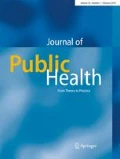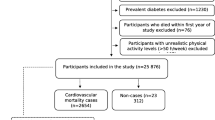Abstract
Background
Current data and available studies suggest that regular physical activity decreases overall mortality. In Germany corresponding findings are scarce. The aim of this data analysis was to clarify this issue for a German sample in men and women.
Methods
A total of 3,742 males and 3,445 females aged 30–69, who participated in a baseline questionnaire in 1984–1986, were followed-up to the year 1998.
Results
During the follow-up period, 300 women and 643 men died. The multivariate rate ratios (RR) for accumulated hours of leisure time sports activities (LTSA) per week and with an LTSA-index based on METs per week with the reference of sedentary lifestyle, showed a clearly protective impact in a dose-response relationship (p for trend <0.05). Similar trends were observed in women and men. More than 2 hours of LTSA per week produced a RR of 0.70 (95% confidence interval [CI]: 0.54–0.91) in men and 0.57 (95% CI: 0.35–0.94) in women. In the group with the highest LTSA-index, the RR was 0.61 (95% CI: 0.44–0.84) in men and 0.46 (95% CI: 0.25–0.85) in women.
Conclusion
LTSA is inversely associated with all-cause mortality in females and males.
Similar content being viewed by others
References
Ainsworth BE (2000) Issues in the assessment of physical activity in women. Res Q Exerc Sport 71:1–16
Ainsworth BE, Haskell WL, Whitt MC et al. (2000) Compendium of physical activities: an update of activity codes and MET intensities. Med Sci Sports Exerc 32 [Suppl]:S498–516
Allison PD (1995) Survival analysis using the SAS system. A practical guide. SAS Institute, Cary North Carolina
Andersen LB (2004) Relative risk of mortality in the physically inactive is underestimated because of real changes in exposure level during follow-up. Am J Epidemiol 160:189–195
Andersen LB, Schnohr P, Schroll M, Hein HO (2000) All-cause mortality associated with physical activity during leisure time, work, sports, and cycling to work. Arch Intern Med 160:1621–1628
Batty GD, Shipley MJ, Marmot M, Davey Smith G (2001) Physical activity and cause-specific mortality in men: further evidence from the Whitehall study. Eur J Epidemiol 17:863–869
Blair SN (1994) Physical activity, fitness, and coronary heart disease. In: Bouchard C, Shephard RJ, Stephens T (eds) Physical activity, fitness and health. International proceedings and consensus statement. Human Kinetics Publishers, Champaign, pp 579–590
Blair SN, Connelly JC (1996) How much physical activity should we do? The case for moderate amounts and intensities of physical activity. Res Q Exerc Sport 67:193–205
Blair SN, Kohl HW, Barlow CE, Paffenbarger RS, Gibbons LW, Macera CA (1995) Changes in physical fitness and all-cause mortality. A prospective study of healthy and unhealthy men. JAMA 273:1093–1098
Boreham C, Riddoch C (2003) Physical activity and health through the lifespan. In: McKenna J, Riddoch C (eds) Perspectives on health and exercise. Palgrave Macmillan, Basingstoke, pp 33–60
Bös K, Brehm W (2003) Bewegung. In: Schwartz FW, Badura B, Busse R et al. (eds) Das Public Health Buch. Gesundheit und Gesundheitswesen. Urban und Fischer, München, pp 156–162
Bouchard C, Shephard RJ, Stephens T (eds) (1994) Physical activity, fitness and health. International proceedings and consensus statement. Human Kinetics Publishers, Champaign
British Medical Association (1995) Alcohol: guidelines on sensible drinking. British Medical Association, London
Bucksch J (2003) Der Einfluss freizeitsportlicher Aktivität auf die Mortalität in einer bevölkerungsbezogenen prospektiven Kohortenstudie. (Master Thesis). Universität Bremen
Club of Cologne (ed) (1996) Health promotion and physical activity. Sport und Buch Strauß, Köln
Davey Smith G, Shipley MJ, Batty GD, Morris JN, Marmot M (2000) Physical activity and cause-specific mortality in the Whitehall study. Public Health 114:308–315
Dorn JP, Cerny FJ, Epstein LH et al. (1999) Work and leisure time physical activity and mortality in men and women from a general population sample. Ann Epidemiol 9:366–373
Fuchs R (2003) Sport, Gesundheit und Public Health. Hogrefe, Göttingen
Gärtner K (2001) Lebensstile und ihr Einfluss auf Gesundheit und Lebenserwartung—Der Lebenserwartungssurvey des BiB. Projekt und Materialdokumentation. BIB, Wiesbaden
Helmert U (1997) Epidemiologische Erkenntnisse zu sportlichen Aktivitäten in der Bevölkerung—Daten der Deutschen Herz-Kreislauf-Präventionsstudie (DHP). In: Schulke HJ, Troschke J von, Hoffmann A (eds) Gesundheitssport und Public Health. Deutsche Koordinierungsstelle für Gesundheitswissenschaften Freiburg, pp 79–85
Helmert U (2003) Soziale Ungleichheit und Krankheitsrisiken. Maro, Augsburg
Jacobs DR, Ainsworth BE, Hartman TJ, Leon AS (1993). A simultaneous evaluation of 10 commonly used physical activity questionnaires. Med Sci Sports Exerc 25:81–91
Jakes RW, Wareham NJ (2003) Epidemiology of activity and physical health. In: McKenna J, Riddoch C (eds) Perspectives on health and exercise. Palgrave Macmillan, Basingstoke, pp 33–60
Kesaniemi YA, Danforth E, Jensen MD, Kopelman PG, Lefebvre P, Reeder BA (2001) Consensus statement. Dose-response issues concerning physical activity and health: an evidence-based symposium. Med Sci Sports Exerc 33 [Suppl]:S351–358
Klein T, Schneider S, Löwel H (2001). Bildung und Mortalität. Die Bedeutung gesundheitsrelevanter Aspekte des Lebensstils. Z Soz 30:384–400
Knoll M (1997) Sporttreiben und Gesundheit. Eine kritische Analyse vorliegender Befunde. Hofmann, Schorndorf
Kujala UM, Kaprio J, Sarna S, Koskenvuo M (1998) Relationship of leisure-time physical activity and mortality. The Finnish Twin Cohort. JAMA 279:440–444
Lee IM (2004) No pain, no gain? Thoughts on the Caerphilly Study. Br J Sports Med 38:4–5
Lee IM, Paffenbarger RS (2000) Associations of light, moderate, and vigorous intensity physical activity with longevity: the Harvard Alumni Health Study. Am J Epidemiol 151:293–299
Lee IM, Skerrett PJ (2001) Physical activity and all-cause mortality: what is the dose-response relation? Med Sci Sports Exerc 33 [Suppl]:S459–471
Lee IM, Paffenbarger RS, Hsieh CC (1992) Time trends in physical activity among college alumni, 1962–1988. Am J Epidemiol 135:915–925
Leon AS, Myers MJ, Connett J (1997) Leisure time physical activity and the 16-year risks of mortality from coronary heart disease and all-causes in the Multiple Risk Factor Intervention Trial (MRFIT). Int J Sports Med 18:208–215
Lissner L, Bengtsson C, Björkelund C, Wedel H (1996) Physical activity levels and changes in relation to longevity. A prospective study of Swedish women. Am J Epidemiol 143:54–62
Malina RM (1996) Tracking of physical activity and physical fitness across the life span. Res Q Exerc Sport 67 [Suppl]:S1–10
Marcus BH, Forsyth LH (2003) Motivating people to be physically active. Human Kinetics Publishers, Champaign
Marcus BH, Forsyth LH, Stone E et al. (2000) Physical activity behavior change: issues in adoption and maintenance. Health Psychol 19:32–41
Marti B, Hättich A (1999) Bewegung—Sport—Gesundheit. Epidemiologisches Kompendium. Paul Haupt, Bern
McKenna J, Riddoch C (eds) (2003) Perspectives on health and exercise. Palgrave Macmillan, Basingstoke
Mensink GBM (1997) Movement and circulation. Population studies on physical activity and cardiovascular disease risk. Ponsen & Looijen, Wageningen
Mensink GBM (1999) Körperliche Aktivität. Gesundheitswesen 61 [Suppl 2]:S126–131
Mensink GBM, Deketh M, Mul MDM, Schuit AJ, Hoffmeister H (1996) Physical activity and its association with cardiovascular risk factors and mortality. Epidemiology 7:391–397
Mielck A (2000) Soziale Ungleichheit und Gesundheit. Empirische Ergebnisse, Erklärungsansätze, Interventionsmöglichkeiten. Huber, Göttingen
Montoye HJ, Kemper HCG, Saris WHM, Washburn RA (1996) Measuring physical activity and energy expenditure. Human Kinetics Publishers, Champaign
Mutrie N, Woods C (2003) How can we get people to become more active? A problem waiting to be solved. In: McKenna J, Riddoch C (eds) Perspectives on health and exercise. Palgrave Macmillan, Basingstoke, pp 131–152
Oguma Y, Sesso HD, Paffenbarger RS, Lee IM (2002) Physical activity and all cause mortality in women: a review of the evidence. Br J Sports Med 36:162–172
Paffenbarger RS, Lee IM (2001) Age specific physical activities and other lifeway patterns influencing health and longevity. In: Hollmann W, Kurz D, Mester J (eds) Current results on health and physical activity. Hofmann, Schorndorf, pp 13–26
Paffenbarger RS, Hyde RT, Wing AL, Lee IM, Jung DL, Kampert JB (1993) The association of changes in physical-activity level and other lifestyle characteristics with mortality among men. N Engl J Med 328:538–545
Paffenbarger RS, Kampert JB, Lee IM, Hyde RT, Leung RW, Wing AL (1994) Changes in physical activity and other lifeway patterns influencing longevity. Med Sci Sports Exerc 26:857–865
Rittner V, Breuer C (1998) Sport—ein vernachlässigtes Medium in der Public-Health-Diskussion. In: Rütten A (ed) Public Health und Sport. Nagelschmid, Stuttgart, pp 259–272
Rütten A, Abu-Omar K (2003) Prävention durch Bewegung. Zur Evidenzbasierung von Interventionen zur Förderung körperlicher Aktivität. Z Gesundheitswiss 11:229–246
Sallis JF, Owen N (1999) Physical activity and behavioral medicine. Sage, Thousands Oaks
Sandvik L, Erikssen MD, Thaulow E, Erikssen G, Mundal R, Rodahl K (1993) Physical fitness as a predictor of mortality among healthy, middle-aged Norwegian men. N Engl J Med 328:533–537
Schlicht W (1994) Sport und Primärprävention. Hogrefe, Göttingen
Schnohr P, Scharling H, Jensen JS (2003) Changes in leisure-time physical activity and risk of death: an observational study of 7,000 men and women. Am J Epidemiol 158:639–644
Shephard RJ (1997) What is the optimal type of physical activity to enhance health? Br J Sports Med 31:277–284
Szyklo M, Nieto FJ (2003) Epidemiology. Beyond the basics. Aspen Publication, Gaithersburg
U.S. Department of Health and Human Services (1996) Physical activity and health. A report of the Surgeon General. Atlanta, GA: U.S. Department of Health and Human Services, Centers for Disease Control and Prevention, National Center for Chronic Disease Prevention and Health Promotion
Varo JL, Martínez-Gonzáles MA, Irala-Estévez J de, Kearney J, Gibney M, Martínez JA (2003) Distribution and determinants of sedentary lifestyles in the European Union. Int J Epidemiol 32:138–146
Villeneuve PJ, Morrison HI, Craig CL, Schaubel DE (1998) Physical activity, physical fitness, and risk of dying. Epidemiology 9:626–631
Vuori I (1998) Does physical activity enhance health? Patient Educ Couns 33 [Suppl]:S95–103
Weller I, Corey P (1998) The impact of excluding non-leisure energy expenditure on the relation between physical activity and mortality in women. Epidemiology 9:632–635
Acknowledgements
The authors thank the German Federal Institute of Population Research (Wiesbaden) for providing the data of the “Lebenserwartungssurvey” for this investigation. We are grateful to Elke Scharnetzky and Marcus Zinsmeister for their help.
Author information
Authors and Affiliations
Corresponding author
Rights and permissions
About this article
Cite this article
Bucksch, J., Helmert, U. Leisure time sports activity and all-cause mortality in West Germany (1984–1998). J Public Health 12, 351–358 (2004). https://doi.org/10.1007/s10389-004-0069-7
Received:
Accepted:
Published:
Issue Date:
DOI: https://doi.org/10.1007/s10389-004-0069-7




